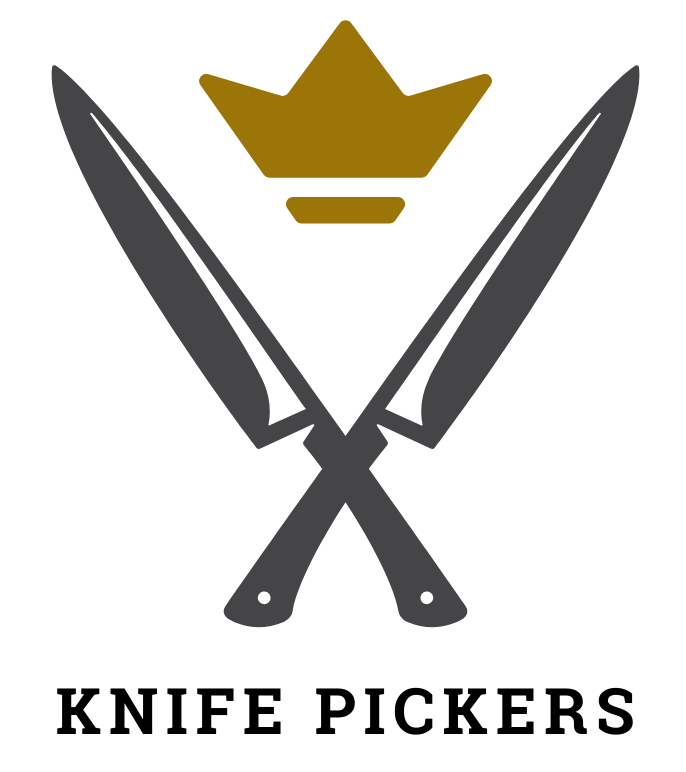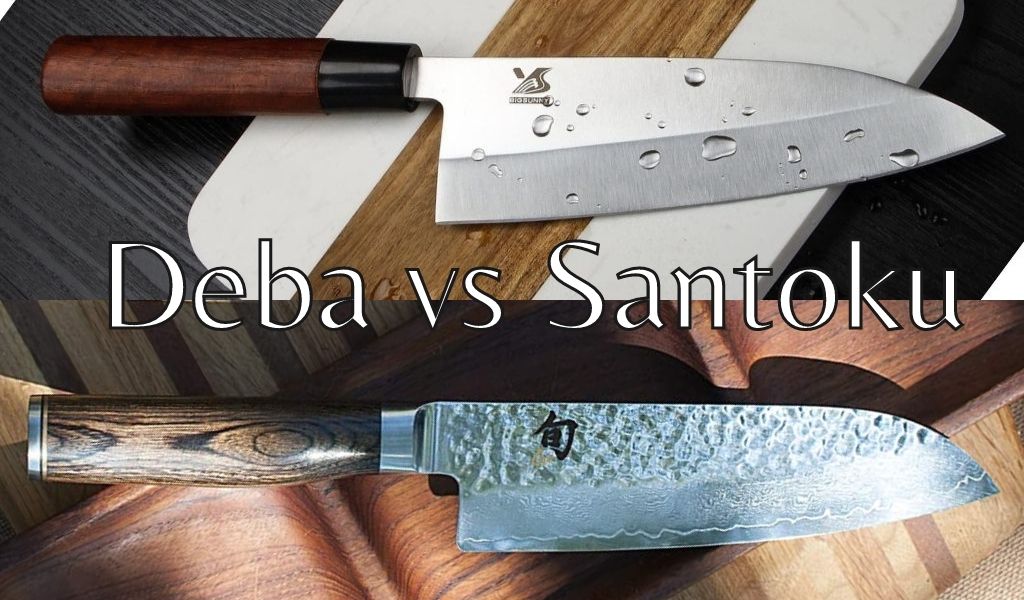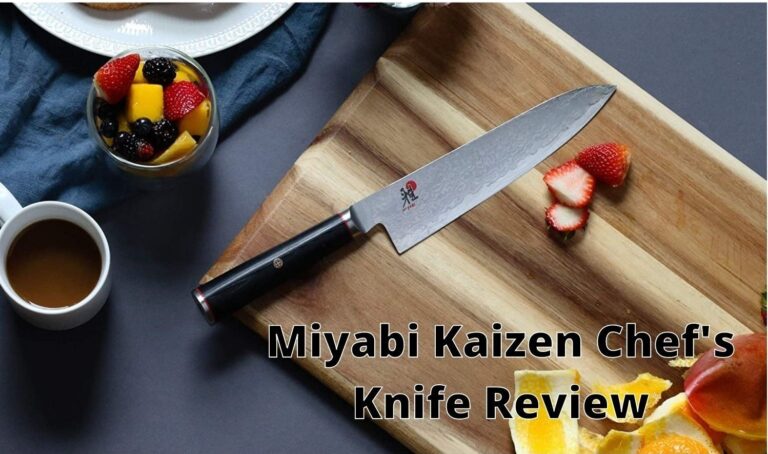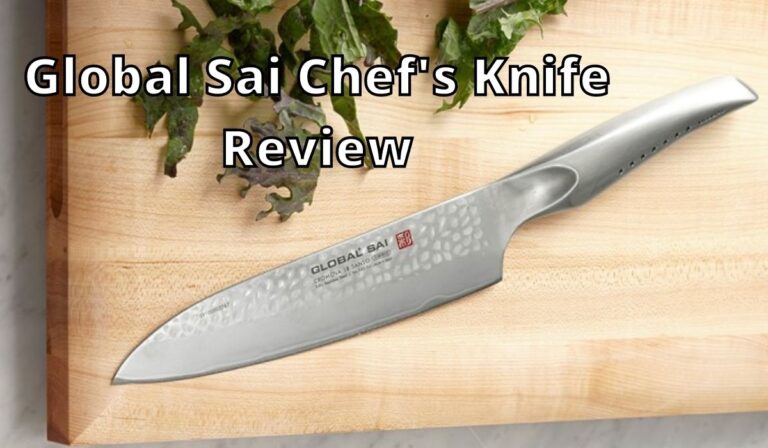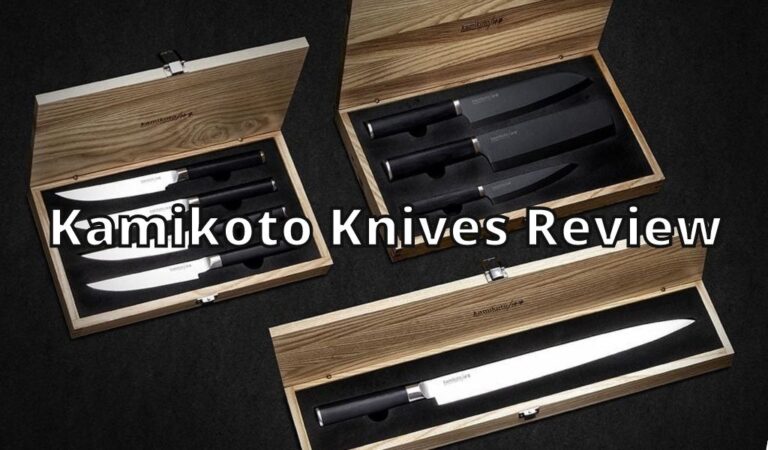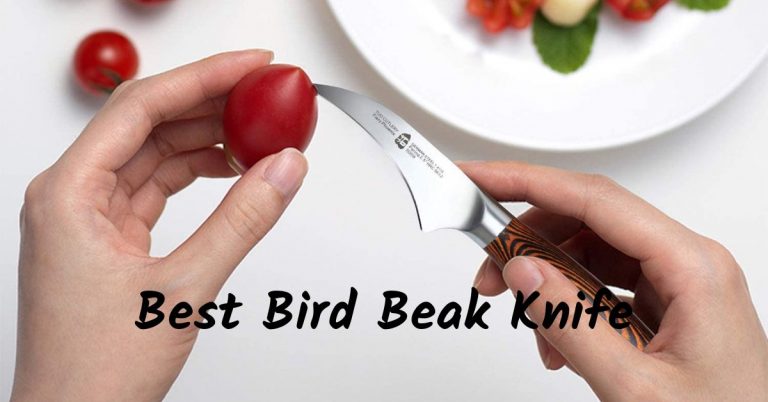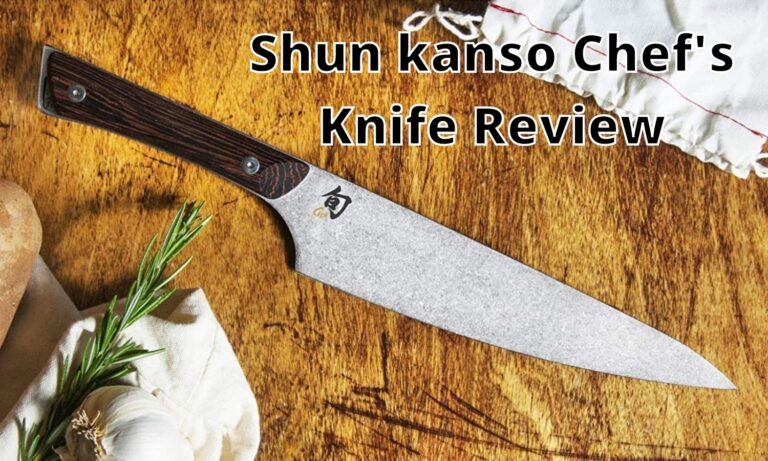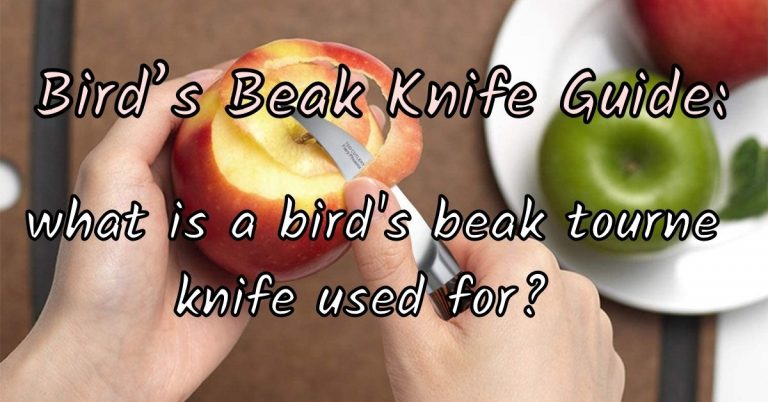Deba and santoku, are the two most common Japanese knives. Both of these Japanese blades are very important tools of every Japanese kitchen. But they have different purposes and features. The deba is a heavier blade used for tasks like breaking down fish or cutting through bones. While the santoku is lighter and thinner, designed mainly for chopping vegetables.
Let’s go through this whole deba vs santoku comparison and review to know more about every different feature and quality of these two knives. And let’s decide which one fits better for your kitchen.
Comparison Table: Deba vs Santoku
If you are in hurry, then before going through this whole santoku vs deba knife review you can go through this quick comparison table.
| Santoku Knife | Deba | |
| Origin | Japan | Japan |
| Category | Modern Allrounder | Traditional |
| Blade Profile | Belly Curves, Low pointy tip | Belly curves, High Pointry Tip |
| Blade spine | Curved spine | Downward Curving spine |
| Function | Copper, Mincer and Slicer | Cut meat from bones and head of fish |
| Kinds of Food to Cut | Fish, meat, vegetable | Fish |
| Handle | Octagonal, round, western | Octagonal, Round |
Top 3 Deba Knife
| Best Overall | Best Under $100 | Best Affordable |
What is Deba Knife?
The Deba is a Japanese-style kitchen knife with a thick spine and sharp blade edge that is pointed at the tip. Traditionally deba is used for cleaning, filleting, and beheading whole fish. It’s also commonly used for breaking down poultry and other meat with small bones as well. But, The Deba knife isn’t suitable for cutting through large or thick bones.
The deba knife is also called a deba-bocho. We can see that it has a characteristic shape like a thick blade and the back edge is not sharp. Usually, this thick blade of deba features an overall length of between 26 and 30 cm.

As traditional Japanese knives, most Deba is single bevel knives. The wide asymmetrical blade allows you to effortlessly glide through delicate fish and create deep, clean cuts. Once you have mastered the technique of using single bevel Japanese knives it feels like a part of your hand.
Top 3 Santoku Knife
| Best Overall | Second Best | Best Affordable |
What is Santoku Knife?
The Santoku is a Japanese knife that is famous for its versatility in use. Its name was translated to mean “three virtues” and refers to the knife’s ability to chop, slice, or dice. The three primary ingredients that the Santoku can be used for are fish, meat, and vegetables.
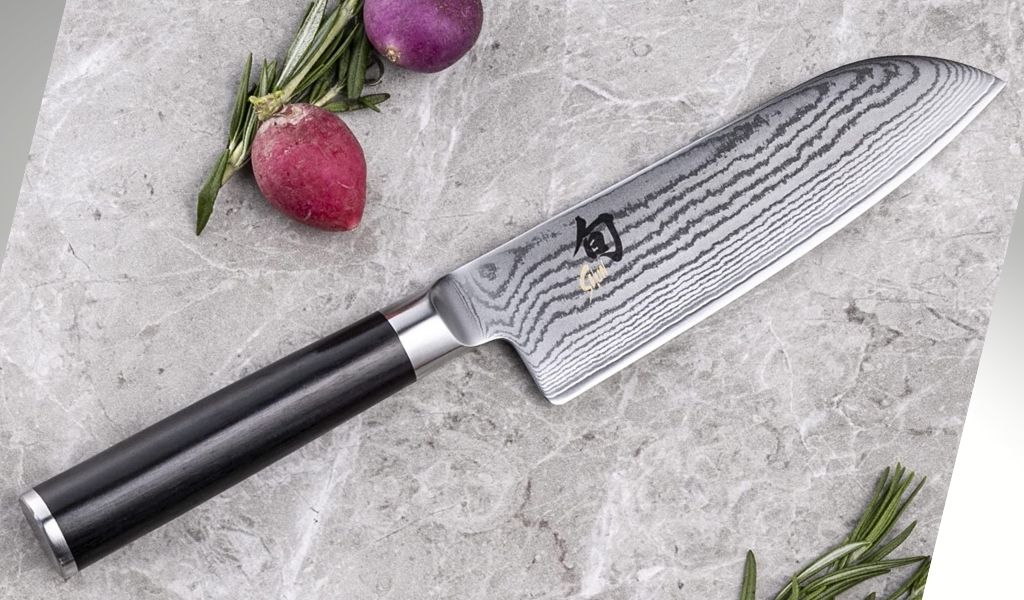
The Santoku is characterized by its straight edge and wide blade. It has a curve, which allows it to rock back and forth for cutting. The blade is flat, allowing the user to push or tap cut. This knife is typically a single beveled. But double bevels are being used because of their popularity in America.
Santoku knife is the most popular knife in Japan and can be found in almost every household. It is often recommended as the more compact Japanese alternative to the classic western chef’s knife. Even it is considered as the alternative to traditional Japanese gyuto knife as mentioned before in this deba vs santoku.
Compared to the western classic chef’s knife, the Santoku is shorter, lighter, thinner. Moreover, it is more hard compared to most of the western chef knife
Origin of Deba and Santoku Knife
Deba Knife
Deba is a Japanese traditional kitchen knife that was invented in the early 18th century. It has a unique structure and high quality. Deba knives were important then because they were used for filleting boneless fish.
This knife was derived from the deba-Kiri, which means beheading knife. It evolved with a pointier tip and wider blade. The blade has a handle similar to the usuba but is heavier and thicker.
And with time, It has become an essential tool for sushi and sashimi preparation, among many other things. We will know more about the construction of deba through this deba knife vs santoku review.
Santoku Knife
The Santoku knife is a Japanese-style kitchen knife, adapted from the traditional Chinese chef’s knife. It first appeared in 1910. The Santoku knife is named after the Japanese city of San-To-Ku, which translates to “three virtues.”. That represents its versatility in terms of slicing, dicing, and chopping. Moreover, as mentioned before in this deba bocho vs santoku comparison, The three virtues can also represent the different types of products that it is designed to handle: meat, fish, and vegetables.
In another explanation, The name comes from the three qualities that are most prized in a santoku: quickness, simplicity, and harmony.
The Santoku is often compared to a western chef’s knife or Gyuto. But its history dates back to the mid-20th century when it first appeared as a home cook’s alternative to the Nakiri. The Santoku design took inspiration from the Nakiri’s tall blade height and straight cutting edge, adding a downward curve of the
In-depth Comparison: Deba vs Santoku
Shape and Design
The Deba knife, a Japanese kitchen knife with a short and wide blade.It has the thickest section at the heel of the blade and tapers toward the cutting edge. It has a pointed tip and its most distinctive feature is its backside, which slopes at an obtuse angle. This allows it to cut off fish.
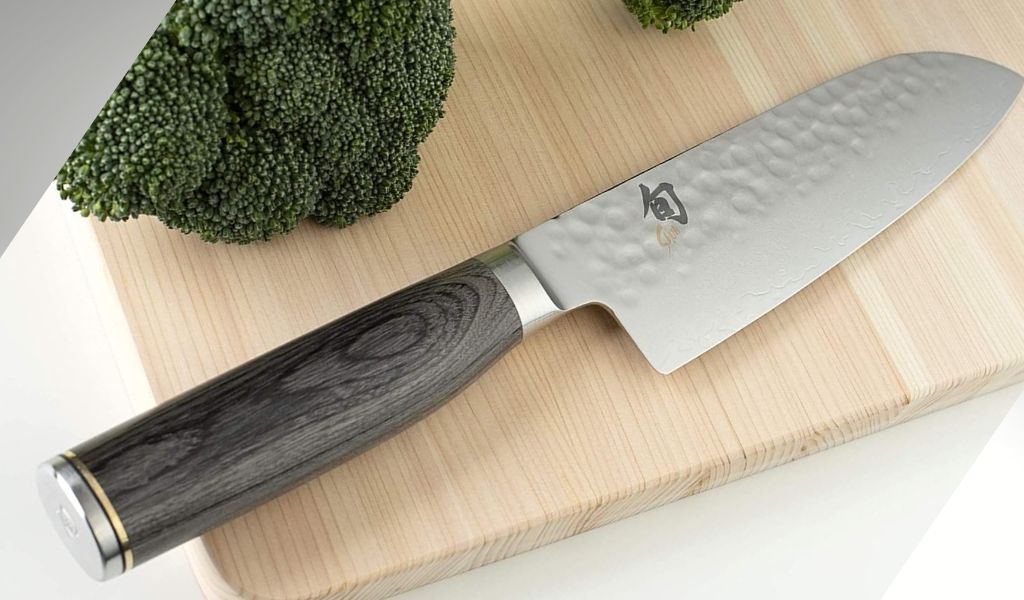
A santoku is a Japanese utility knife with a blade that is about 6 to 10 inches long and is often used for home cooking. Santoku knives have a flat blade with a gentle curve that leads to its rounded point. The thin blade has grantons along the length of the blade, which makes it easier to release food from the knife when dicing or slicing.
The blade of a Santoku knife is shaped in such a way that it allows for swift downward chopping and tap-chopping. In addition, the straight edge of the front portion of the blade is well-suited for push cutting. This makes it great for chefs who are used to using western knives and want to try something new. The one problem with this style

Size
There are several styled deva knives, but the most common is the Hon-Deba.Hon-Deba knives have sharp, tough blades that are typically 150mm to 330mm in length and 5mm to 9mm thick. The average user should choose a 180mm blade length.
The Santoku is a relatively shorter chef’s knife, with most blade lengths falling between 130-200mm. Its compact length and thin blade make it smaller and lighter than a chef’s knife. These features make it an ideal choice for those with smaller hands or for minimizing fatigue and strain in long time use.
165mm is the most suitable blade length for home cooks and professionals alike. And as described in this deba vs santoku review, The length is enough to handle most types of products without being too cumbersome.
Handle
Knife handles can be divided into two categories: the traditional Japanese Wa-Handle, and a Western handle. Most of the Deba knives feature a wooden Japanese-style Wa-Handle.
Santoku knife handles also can be divided into two categories, the traditional Japanese “Wa-Handle” and a Western-style handle.
The most common Japanese wa-handle shapes are the D shape, oval, or octagonal. While some user prefers the ergonomic grip of an octagonal or D-shaped handle, the choice of the handle comes down to the personal preference of users.
Edge
The single bevel blade of the deba knife features an extremely sharp edge. This type of blade is very common in Japanese knives as it creates an extremely sharp edge. In this type of knife, the blade is ground (sharpened) on only one side, usually at an angle between 10 to 15 degrees.
This one-side edge makes it ideal for clean cuts that preserve the natural freshness, flavor, and texture of the food.
Most single bevel knives are created for right-handed cooks. So if you are left-handed, be sure to look for left-handed Deba knives.
Traditionally, Santoku knives feature a single bevel blade. As mentioned earlier in this deba knife vs santoku article, Single bevel blades naturally tend to be sharper than double bevel blades. But it requires significant skill to master the natural steer of the asymmetrical blade.
The Santoku knife is now also widely available with a double-bevel blade. And that also maintains the signature sharp edge of Japanese knives. The double-bevel Santoku is also ambidextrous. And it allows users to use it for both left-handed and right-handed users.
What does a deba knife do best?
A Deba knife is used to cut through whole fish, including filleting the fish and cutting through its bones. The significant weight of the deba blade allows you to make strong cuts and cleanly slice through even the hardest parts of the fish. It is also commonly used to cut poultry meat as well as other meats with small bones.

Like most other Japanese knives, the deba is a specialized knife that works best when doing what the knife was created to do. It is especially useful when working with whole fish. Because every part of the blade serves a specific purpose. The sturdy heel of deba knives allows you to easily remove the fish head and tail cut through small bones.
The smaller pointed tip of the deba knife allows you to feel the bones and helps filet the flesh from the bones. The center of the edge allows you to glide along the spine. And allows you to carve as closely to the bone as possible. It can also be used for slicing, filleting, and removing fish skin and scales as described again and again in this whole santoku vs deba knife comparison.
If you’re used to using a Western-style fillet knife for handling fish, the Deba may feel a little foreign in your hands at the beginning. But with practice, you’ll master the cutting technique and use less effort to produce beautifully deep and precise cuts of fish.
What does a santoku knife do best?
The Santoku knife is a Japanese version of the traditional chef’s knife. It is best for chopping, dicing, and mincing food such as meat, fish, and vegetables. The sharp, thin blade combined with a straight cutting edge makes this knife ideal for swift clean cuts up-and-down. Or you can use a tap-chop or push-cut.
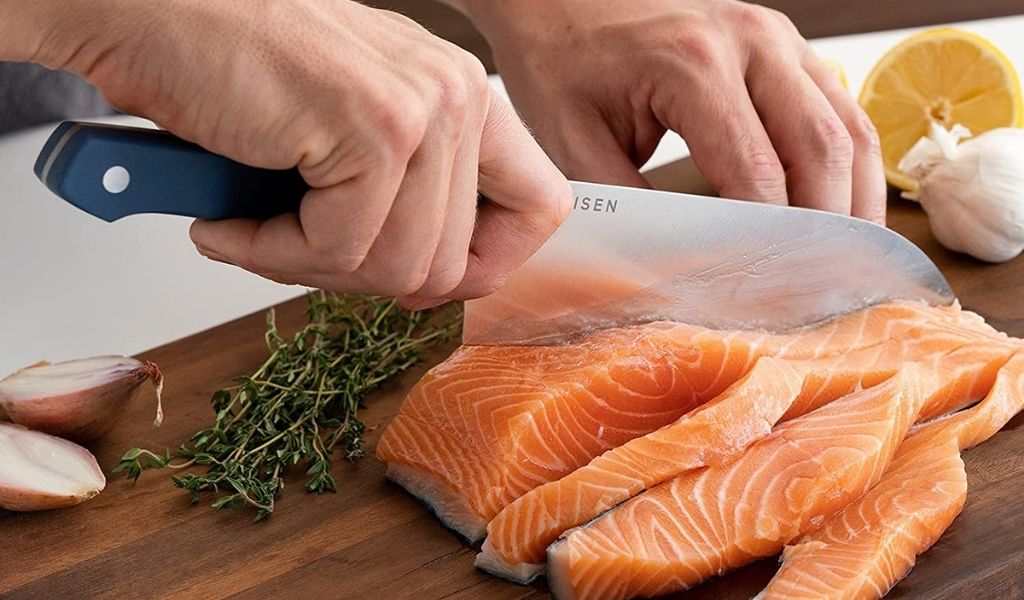
Moreover, The Santoku knife is thick and flat with a sharp point. It excels at cutting thin slices of meat, seafood, cheese, fruits, and vegetables. The wide blade of the santoku knife is handy for scooping food off the cutting board.
As mentioned earlier in this deba vs santoku review, Santoku is a single bevel knife that makes it an ideal tool for achieving clean cuts. And its cut preserves the natural freshness, flavor, and texture of the food.
Different Types of Deba Knives.
Ko-Deba/Aji-Deba
The Ko-Deba is a smaller deba used for cleaning and filleting small saltwater and freshwater fish. The word “Ko” in Japanese means “small” or “short” in English.
Ai-Deba
The ai-deba knife is a thinner and more light version of the hon-deba knife, with a narrower blade that ranges from 135mm to 270mm. The Japanese word “ai” means “both” in English. And it refers to the ai-Deba’s exceptional ability to both fillet and slice medium-sized fish.
Yo-Deba
The Yo-Deba is a Western-style variant of the Hon-Deba. It features a double bevel edge and is lighter than its predecessor. The blade length ranges from 165mm to 300mm.
Mioroshi-Deba
The Mioroshi-Deba is a knife used for filleting fish with a blade that is 165mm to 330mm long. The name comes from the fact that it was designed to be used as a substitute for both the Deba and Yanagiba knives. This saved fishermen from having to carry two knives in their boats.
Kanisaki Deba
The Kanisaki-Deba is a specialized deba designed to fillet sea creatures. The blade ranges from 180mm to 210mm and it has a cutting edge on the left side. That’s why it won’t touch the meat of the crab while cutting.
What is the popular Santoku Knife Brand?
Santoku knives are now made by a variety of Japanese and western knife manufacturers including:
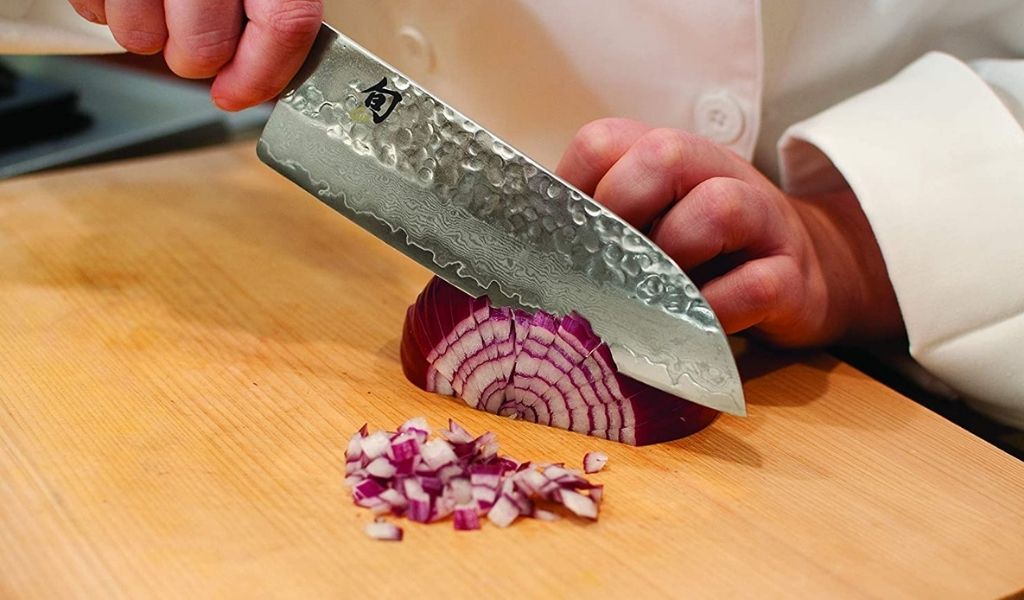
- Yoshihiro
- Tojiro
- Gesshin Uraku
- Masamoto
- Mercer Culinary
- Shun
- Miyabi
- Kamikoto
- Wusthof
- Zwilling J.A. Henckels
- Victorinox
- Global
FAQ
1. What is the best Deba Knife?
With a combination of beautiful design and quality material, the Kai wasabi black deba knife is one of the best deba knives. Other companies like Yoshihiro, tojiro, Dalstrong produce quality deba knives.
2. What is the best Santoku Knife?
If you are looking for a high-end santoku knife then Shun premier santoku is a great option. You can also have the classic series santoku of the same knife maker.
Conclusion
If you have gone through this whole deba vs santoku comparison, then you must have got a clear idea about these two knives. Santoku and Deba both are the most commonly used Japanese kitchen knives. Their main differences between them are shape and usage.
Santoku is a Japanese knife that can be used for cutting, slicing, and dicing. It has a fantastic ability to cut just about anything.
On the other hand, Deba has a very similar shape to Santoku but is bigger. Its blade is usually around 2 inches longer than the Santoku’s blade, making it perfect for butchering fish and boneless meat.
So, now it depends on you to select which knife fits you more. If you want a large knife with fish and meat cutting quality then go with a deba knife. And if you want a short knife with quick cutting, slicing, and dicing quality then a santoku knife is a better option for you.
Other Comparisons:
